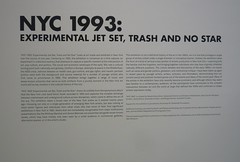Walking to CBGB on the way to a hardcore matinee in 1997 made me think about the contrast between the relatively safe Giuliani-era Bowery and the sleazy punk scene born there twenty years prior. Even 16 years ago, the thought of Television or Blondie playing the venue seemed distant as I watched a boy answer a bulky flip phone while waiting in line.
Despite constantly being surrounded by the familiar cultures of skateboarding, indie rock, and art, it wasn’t until I entered the lobby of the New Museum to view “NYC 1993: Experimental Jet Set, Trash and No Star” that I felt their impact on downtown culture today and also felt like a relic.
While there is a long and impressive list of artists that contributed to “NYC 1993,” it’s Larry Clark’s mounted skateboard decks, stickers, and stills from his 1995 movie “Kids” that dominate the exhibit. A deck with a hanging Klansman is mounted on the main wall next to one with a naked woman. Next to them is another with a swastika and Star of David with the text, “Never Forget 6,000,000 Dead.”
In 1993, most East Coast skateboarding scenes were tight-knit enclaves for latchkey kids and diehards: skating was far from a sport. “Kids” depicted that culture and the drinking, drugs, and sex that surrounded it in a new light that disturbed many. Because skateboards weren’t lining the shelves of department and sporting goods stores and they were produced in such small runs, their graphics could be as taboo as the designer wanted. Deck design hasn’t become completely tame, but at a time when the industry was so small, there was no filter.
Back then, the worlds of art, indie rock and skateboarding were immense to those immersed in them, but insignificant to pop culture largely because they weren’t yet generating the capital they’d eventually produce. Streetwear, X Games, and the iconic New York brand Supreme hadn’t been founded. The amateurs who starred in “Kids” — Chloe Sevigny, Rosario Dawson, Leo Fitzpatrick and both the late Justin Pierce and Harold Hunter — hadn’t yet achieved mainstream notoriety.
“Kids” wasn’t the first time skateboarders were on the silver screen, but it was the first time they were shown in such a serious light. Hollywood’s prior attempts — including “Thrashin’” and “Gleaming the Cube” — were marred by weak scripts and poor acting, and only live on as kitsch. Clark’s depiction of downtown kids taking drugs and having unprotected sex was the furthest away from the squeaky clean personas of Andy MacDonald and Tony Hawk, two vertical skateboarders who would become brand names due to the success of the X Games.
Skateboarding’s commercial rise in the late ’90s was certainly aided by the attention X Games drew to the sport, but there were other pivotal factors including the success of Hawk’s namesake game, Tony Hawk Pro Skater, and World Industries’ shift from the edgy graphics in Clark’s exhibit to kid-friendly cartoons.
With a younger fan base interested in the sport and corporate sponsors investing, skateboarding was growing exponentially — the problem was the lack of public spaces for the budding enthusiasts. The public skate-park boom in the late ’90s and early 2000s was a sharp contrast from the street skaters depicted in “Kids.” Once you take kids off the streets and put them in the sterile concrete environment of a park the outlaw image of the sport disappears.
Instead of trespassing or damaging ledges and curbs, they were now given public spaces. In the public’s eye this made them athletes. The MTV show “Jackass” also helped legitimize the sport: with Spike Jonze as a co-creator, the show was able to gain the attention of a mainstream audience without offending the diehards.
Reflecting on it now, Clark’s original critics might still think of skaters, graffiti, and hip-hop kids as dangerous, irresponsible, and angry, as they never fully embraced or understood the rise of the sport in pop culture. The real difference is in that of Generation Z and the Millennial Generation who grew up with skateboarding on their television, on movie screens, and with a skate park in their town. There’s nothing shocking or dangerous to them about riding a skateboard in Lower Manhattan, underage drinking, or pre-marital sex: these are things they’re exposed to everyday. The impact of what Clark was depicting wouldn’t have the same effect now.
“NYC 1993” might not completely contextualize what was significant about the downtown youth culture of the early-mid-90s, but it certainly does explain that we’re not still living in 1993 – we’ve just commercialized it.




